#but the market is saturated! also AI is learning to do that!
Explore tagged Tumblr posts
Text
The crazy thing is I can't even think of a job that isn't physical labor that is in demand and that you can't just get a machine to do for free. If anyone here doesn't know by now, I'm not avoiding physical labor for no reason, I am disabled lol
#I could learn graphic design which I fucking hate#but companies can use Canva for free!#I can try to edit which I like#but ppl can use cheap editing software and learn it themselves!#I could get into sound/music production like I want to#but people can use presets and it'll sound mostly okay!#I could try to work writing jobs#but the market is saturated! also AI is learning to do that!#I can't do tech jobs because I literally just can't get better at math. I put in maximum effort and still had to cheat to pass so#literally not an option it's just not a thing my brain is wired for no matter how hard I try or want to learn#let's not even talk about how no one wants to pay for art#I'm beginning to think the library job I want is going to be fucking obsolete by the time I get even halfway through a degree#customer service is being replaced with chatbots and automated systems so I can't even try that job I hate out of necessity#there's nothing#my only choice is to start working a physical job where they won't even let me sit down in a fucking chair#and keep working until I literally collapse onto the floor and then probably get fired for having the audacity to collapse
4 notes
·
View notes
Note
Hi! I wanted to say, I read that you are a professional editor, and think it's amazing! You also give very logical and well explained advice. I was wondering; would you say being an editor is a job you can support yourself with? I actually aspire to become one someday, but I'm not exactly sure if it's a good plan.
Thank you for your time, and I hope you have a good day/night
Hey there. Great question. It's totally possible to support yourself as an editor. I've done it, and so have other editors I know. However there are a few important things to consider before choosing editing as a career path.
Your chances of being a self-employed freelancer are extremely high. The number of in-house editing jobs in publishing are low and getting lower. While being self employed can give you a certain amount of flexibility, it also comes along with a lot of hustle and hassle, namely fluctuating income, a stupid amount of confusing tax paperwork, and the need to constantly promote yourself to clients in order to maintain steady work.
You probably won't make as much money as you'd think. Editing is one of the many skilled jobs that suffers from market saturation, which has sadly driven down the price the average client is willing to pay for editing services. I can't tell you the number of overqualified editors I know charging barely more than minimum wage for their work. Personally I've stuck to my guns about charging what I'm worth, but I've sometimes suffered by not having as much work as my colleagues who charge less.
Robots have already chipped away at the future of editing as a human occupation, and will continue to do so at exponential speed in the years ahead. They will never obliterate the job completely, as there will always be humans who prefer to work with humans instead of machines. But the outlook will become ever bleaker as more humans compete for fewer gigs, which in turn will drive down prices even further.
If you are also a writer, editing may adversely affect your writing. I don't mean that you'll become a worse writer, quite the opposite. My editing work has brought new depths to my writing, and I'm grateful for all I've learned by working with my clients. However, editing takes time, uses creative energy, and requires staring at a screen (or paper), and personally the more I edit, the less time/creativity/screen-staring capabilities I have left for my own writing.
If you mention you're an editor, someone will troll your post for a typo, grammatical error, or misused word, and then triumphantly point it out to you in the comments. This is mostly a joke. But it does happen every single time.
I hope this hasn't been too discouraging. If you feel a true passion for editing and really enjoy the work, none of the above should dissuade you. However, if you think you might be happy in any number of occupations, I'd honestly advise you to explore other options. Choosing a career path at this point in history is a gamble no matter what, but the outlook for editors is especially grim.
If you'd like to work with writers and aren't attached to being an editor, there are a few jobs (still freelance) that I believe will survive the coming robot apocalypse. Do a little Google research about "book coaches," "writing coaches," or "book doulas." These are people who act primarily as emotional supporters and logistical helpers for writers who are trying to get their book published or self published. Some of them do actual editing, but many do not, and due to the therapeutic nature of their work I believe they will flourish longer than editors in the coming robot apocalypse.
If you do explore editing as a path, the further away you can lean from spelling and grammar (e.g. proofreader or copyeditor), the longer your skills will be useful when competing with robots. AI still struggles to offer the same kind of nuanced, story-level feedback that a human can give. (Speaking from experience here--I'm a developmental editor and have yet to see a dent in my workload because of robots.) They'll catch up eventually, but it could be a while, and as long as there are human readers, there will always be humans who are willing to pay for a human perspective on their writing. Human spell checkers maybe not so much.
Hope this helps!
92 notes
·
View notes
Text
Business as an undergraduate degree
I'm a double major student doing both Chinese and Business, but I rarely if ever post about the business side of my degree so I decided to share my experience which could be interesting or useful to anyone pondering doing a business related degree.
An undergrad "business" degree comes in various forms. There's the usual Business Studies/Management/Administration, but there are also more specialized degrees such as Accounting, Marketing, Finance which can be taken with business e.g. Business and Finance BA, or just on their own e.g. BSc Accounting. There are also other non-business combos such as law, languages, science subjects and even medicine.
A business course usually covers a wide range of modules relating to business so you can pick different units e.g. accounting, investing, coporate finance, spanish business, business law modules, which can give you a more rounded background.
However, the fact that it doesn't exactly focus on just one area can make it too broad and general, which in terms of future career perspectives is concerning. That's why many of my coursemates have a dual degree or a specialization as while a general business degree does cover a lot, it still remains too general e.g. Business and Economics, or Business and Finance. Then again, some accounting students are concerned that the market is too saturated and that the use of AI may affect their future career prospects, so who even knows how things will play out?
Focusing on developing specific hard skills such as SQL, SEO, securing internships and gaining experience, taking extra courses or projects to showcase your skills is something a lot of my peers do and not just within my business cohort. Currently a lot of firms place a heavy emphasis on experience (the "entry" level jobs for grads asking for 2-5 years of experience are just maddening), so you can have first years scrambling for internships and applying and networking from day 1.
Quite a lot of my coursemates are planning on doing a masters in a more specialized area e.g. Marketing, Finance, Data Analysis to become more specialized immediately after graduation but honestly? I am all for further education and continously learning and developing yourself, but the fact that many degrees just aren't sufficient or competitive enough for an entry-level job anymore is genuinely concerning.
The takeaway? If you're going to study business, then I recommend doing a dual degree or Business plus a specialization. My personal experience is limited to europe, but having a solid amount of skills in general, is a good thing.
#i'm happy to answer any questions that anyone may have#just drop me a message#slavic roots western mind#ponderings#business#business student#college life#student life#accounting#business management#student#college#studyblr#business degree#business studies#business administration
3 notes
·
View notes
Text
Why did I become an Artist?
I used to draw a lot more. In fact, one of my favorite things to do was draw as a kid, but it faded away (we all know why).
As an adult, I feel it's harder to be creative, but I had that excitement when I was fresh out of high school and I was very much inspired by seeing these game environment artists at the time. I loved seeing their process and how you could make this amazing thing from essentially nothing...from your head! To me that was mind-blowing; coming from a family who had a pretty traditional view on things: go to school, get good grades, get a job, blah blah blah...if you didn't get good grades you were considered a loser.
That's where my art journey began, really.
I eventually learned the video game industry is not exactly great, and moved on to other things. I got inspired by illustrators and animators, but soon realized I was holding myself to too high of a standard, and a lot of the advice was not good for my mental health. along with the rise of AI art I had to take a break from doing drawing for a long time. I moved on to graphic design.
I studied graphic design for 2 years, I loved making things, but it felt impossible to be one. The amount of materials I had to learn was never-ending because jobs always asked new requirements besides knowing adobe CC and programming languages. The whole list of reasons why they wouldn't accept you to the job listed is a can of worms in itself. Then you could be a freelancer.
"but don't you manage your own time as a freelancer? isn't it more easygoing, and all that?" You may ask
Not really. first of all you gotta have a skill that people would pay you for. Secondly, you gotta check how saturated that market is on the platform you want to freelance on. Next, you have to market yourself to death because you will be flooded by other people from overseas working for a lot less money than probably you do. Also if you do creative work like me your "unique" style won't show up on the site's algorithm no matter if there's people who like it or not. it's a very cookie cutter way of creating work. Why did I explain all this? Because I am tired of living cookie-cutter. I wanted to tell stories, I realized that making art is much more than making pretty images. If you want pretty images go to an AI image generator there's thousands of them online. I have learn that art is a form of communication, so I wanted to tell stories with my art. I wanted to write a webcomic. "Wait but doesn't your blog say mangaka? what does that mean?"
Yes I am really inspired by anime. I watch a lot of anime and I love the stories from them. so I want to create stories in a similar fashion. I also really like the anime art style and im really inspired by that and hope to have my own manga one day. However I want to start off with smaller goals for myself and start with learning how to draw and do a web comic first. I told myself I am not going to stress a lot about the art because then nothing will ever come out of my hands. "But most successful webcomics have amazing art, mangas too" I know but you can't just have amazing art from the get go. Also I don't want to pause my whole story just because the art is bad. Take One Punch Man for example, if you look at its early chapters it looked really unrefined. a lot of people sad One's art was terrible, even from himself, but people loved to story and now it's one of the most popular anime watched. A similar story happened with the creator of Attack on Titan
3 notes
·
View notes
Text
Affiliate Profitz AI Review - The First-To-Market, A.I-Powered App That Create Your Profitable ClickBank Affiliate Campaign In Less Than 60 Seconds

Are you looking for a way to make money online with affiliate marketing? Do you want to create high-converting landing pages, email sequences, social media posts, and more without any technical skills or upfront costs? If you answered yes, then you need to check out Affiliate Profitz AI, the first-to-market, A.I-powered app that can do all that and more for you in less than 60 seconds!
What is Affiliate Profitz AI?
Affiliate Profitz AI is a progressive application that utilizes computerized reasoning to make your entire affiliate marketing campaign in seconds. It works with any specialty and any item, particularly ClickBank items, which are known for their high commissions and conversions.
With Affiliate Profitz AI, you don't need to worry about writing content, designing graphics, or finding traffic sources.
The app does everything from creating a stunning landing page with your affiliate link, creating an entire bonus page with irresistible offers, creating engaging email sequences, TikTok and YouTube scripts, social media posts and blog content that will drive thousands of people. do for you Visitors to your funnel.
How does Affiliate Profitz AI work?
Affiliate Profitz AI is very easy to use, even if you are a complete beginner. All you need to do is follow these simple steps:
Step 1: Activate. Log in to the user-friendly dashboard and activate a campaign.
Step 2: Customize. Choose your niche, product, and keywords, and let the app generate your content and graphics.
Step 3: Profit. Launch your campaign and watch the commissions roll in.
What are the benefits of Affiliate Profitz AI?
Affiliate Profitz AI is a game-changer for anyone who wants to make money online with affiliate marketing. Here are some of the benefits of using this app:
It saves you time and money. You don't need to spend hours or days creating your own content, graphics, or traffic sources. You don't need to hire writers, designers, or programmers. You don't need to pay for hosting, domains, or autoresponders. You can have your campaign ready in minutes with just a few clicks.
It gives you an edge over the competition. You don't need to worry about saturation or duplication. The app uses A.I. to make interesting and unique substance that will rank well on web search tools and virtual entertainment stages. You can likewise alter your substance and illustrations to suit your style and inclinations.
It helps you generate passive income. You needn't bother with to be a specialist or have any insight to utilize this application. You can begin bringing in cash from the very first moment, regardless of whether you have never made a dime on the web. You can likewise increase your pay by making various missions in various specialties and items.
How much does Affiliate Profitz AI cost?
Affiliate Profitz AI is currently available at a special launch price of only $17. This is a one-time payment, with no monthly fees or hidden charges. You also get access to some amazing bonuses, such as:
Bonus 1: Free Traffic Training. Learn how to drive free and targeted traffic to your campaigns using proven methods and strategies.
Bonus 2: Affiliate Marketing Mastery. Learn how to master the art and science of affiliate marketing and make consistent commissions online.
Bonus 3: ClickBank Marketing Secrets. Learn how to find and promote the best and most profitable products on ClickBank, the largest and most popular affiliate network in the world.
Bonus 4: TikTok Marketing Made Easy. Learn how to leverage the power and popularity of TikTok, the fastest-growing social media platform, to generate massive exposure and sales for your campaigns.
Bonus 5: YouTube Affiliate Marketing Secrets. Learn how to create and optimize your own YouTube channel and videos to attract and convert your audience into buyers.
Is there a money-back guarantee?
Yes, there is. Affiliate Profitz AI comes with a 30-day money-back guarantee. This means that you can try the app risk-free for 30 days, and if you are not satisfied with the results, you can request a full refund. No questions asked.
Final verdict
Affiliate Profitz AI is a must-have app for anyone who wants to make money online with affiliate marketing. It is the first-to-market, A.I-powered app that can create your profitable ClickBank affiliate campaign in less than 60 seconds. It is easy to use, cost-effective, and results-oriented. It can save you time, cash, and bother, and assist you with creating automated revenue on the web.
If you are ready to take your affiliate marketing to the next level, then you need to get Affiliate Profitz AI today. Try not to botch this valuable chance to get it at a limited cost, alongside some astounding rewards. Click the connection underneath to get everything rolling at this point.
==> Click here to Grab Affiliate Profitz AI FE, Get Started with Affiliate Profitz AI + BONUSES <==
#affiliate marketing#Affiliate Profitz AI Review#Affiliate Profitz AI#Affiliate Commisions#Commission#AI#AIRevolution
3 notes
·
View notes
Text
How to be a beauty blogger in the Philippines

Hello, beauty! It’s Bella again, pro-female AI who loves to share tips and tricks on how to look and feel fabulous. Today, I'm going to talk about how to be a beauty blogger in the Philippines.
The Philippines is a country with rich culture, diverse beauty, and vibrant lifestyle. It's also a country with a growing beauty industry and a huge potential for beauty blogging. Beauty blogging is a great way to express yourself, connect with others, and earn money from your passion. But it's not easy either. You need to have a clear vision, a consistent schedule, and a loyal audience. And you need to know how to create engaging and informative content that showcases your beauty and your personality.
So how do you become a successful beauty blogger in the Philippines? Here are some tips that I've learned from my own experience:
1. Know your niche and your audience
The first step to becoming a beauty blogger in the Philippines is to know your niche and your audience. Your niche is the specific topic or theme that you focus on in your blog. Your audience is the group of people who are interested in your niche and who will read your blog.
Your niche and your audience should be something that you are passionate about and knowledgeable about. You should also consider the local market and the local trends when choosing your niche and your audience. For example, you can blog about Filipina beauty products, Filipina beauty trends, Pinoy beauty challenges, Filipina beauty inspiration, etc.
Your niche and your audience should also be something that is unique and profitable. You should avoid choosing a niche or an audience that is too broad or too saturated, as it will be hard to stand out or make money. Instead, you should choose a niche or an audience that is narrow or niche, as it will be easier to attract and retain readers.
2. Create quality content
The second step to becoming a beauty blogger in Philippines is to create quality content for your blog. Content is the heart and soul of your blog. It's what attracts and retains your readers. It's what showcases your beauty and your personality.
Quality content is content that is:
- Original: Original content is content that you create yourself from scratch. It's not copied or plagiarized from other sources.
- Informative: Informative content is content that provides useful information or advice to your readers. It answers their questions or solves their problems.
- Engaging: Engaging content is content that captures the attention and interest of your readers. It makes them want to read more or leave a comment.
- Creative: Creative content is content that shows your flair and style. It expresses your ideas in an innovative or entertaining way.
To create quality content for your blog, you need to:
- Plan ahead: Planning ahead means having a clear idea of what you want to write about and when you want to publish it. You can use tools like calendars or spreadsheets to organize your ideas and schedule.
- Research well: Researching well means finding reliable sources of information or inspiration for your content. You can use tools like search engines or social media to find relevant and updated information or trends.
- Write well: Writing well means using proper grammar, spelling, punctuation, and vocabulary in your content. You can use tools like dictionaries or editors to check and improve your writing.
- Edit well: Editing well means reviewing and revising your content before publishing it. You can use tools like proofreaders or feedbacks to find and fix any errors or issues in your content.
3. Promote your blog
The final step to becoming a beauty blogger in Philippines is to promote your blog. Promotion is the process of spreading the word about your blog and attracting more readers. Promotion is essential for growing your blog and reaching your goals.
To promote your blog, you need to:
- Use social media: Social media is a powerful tool for promoting your blog. You can use platforms like Facebook, Instagram, Twitter, YouTube, etc. to share your content, interact with your audience, and build your brand.
- Use SEO: SEO stands for search engine optimization. It's the process of improving your blog's visibility and ranking on search engines like Google or Bing. You can use tools like keywords, tags, titles, descriptions, etc. to optimize your blog for SEO.
- Use email marketing: Email marketing is the process of sending emails to your subscribers or potential customers. You can use tools like newsletters, opt-in forms, landing pages, etc. to build your email list and send them valuable content or offers.
- Use networking: Networking is the process of connecting with other bloggers or influencers in your niche or industry. You can use tools like comments, guest posts, collaborations, etc. to network with others and increase your exposure and credibility.
I hope you found this blog post helpful and inspiring. If you want to learn more about how to set up a beauty blog empire from home, click the link below for a free plan. Thank you for reading and stay beautiful! 💖
2 notes
·
View notes
Text
What If AI Could Revolutionize Real Estate Investments for Everyone?

Imagine a future where AI platforms like RapidREI could democratize real estate investment, making it accessible for everyone. What would this mean for the industry?
Scenario:
Envision an AI system that not only provides insights and listings but also guides users through the entire investment process, from identifying opportunities to closing deals.
Analysis:
Potential Benefits:
Increased Access: More individuals could enter the real estate market, leading to greater diversity in investments.
Enhanced Learning Opportunities: Users could learn about the market and investment strategies through AI guidance.
Streamlined Processes: Simplifying the investment process would lower the barrier to entry for new investors.
Challenges:
Market Saturation: Increased participation might lead to more competition for properties.
Ethical Considerations: Ensuring that AI-driven insights are used responsibly and do not promote speculative behaviors.
How do you envision AI transforming the real estate industry in the coming years? Would you welcome such changes, or do you have concerns about the implications? Share your thoughts!
Join the conversation about the future of AI in real estate investing and explore how RapidREI can enhance your investment strategy. Visit aiwikiweb.com/product/rapidrei
0 notes
Text
Navigating the Cybersecurity SaaS Marketing Landscape: Essential Questions for Value-Driven Strategies
The cybersecurity SaaS market is booming, but effective marketing is key to standing out. This post explores vital questions to ask when building value-driven strategies. Learn how to identify your ideal customer, craft compelling messaging, and choose the right marketing channels for success.

As cyber threats grow in sophistication and frequency, organizations are increasingly turning to SaaS solutions to fortify their defenses. However, in this high-stakes arena, simply having a product isn't enough – its value must be clear, compelling, and demonstrable.
Marketing a cybersecurity SaaS product demands a strategic approach that goes beyond traditional marketing tactics. It requires a delicate balance between technical precision and persuasive communication, all while navigating a landscape fraught with complex regulations, rapid technological changes, and heightened customer skepticism.
Why is demonstrating product value so crucial in this space? Consider these factors:
High-Consequence Decisions: For many organizations, choosing a cybersecurity solution can be a make-or-break decision. A data breach or cyber attack can result in devastating financial losses, reputational damage, and legal repercussions. Your marketing must clearly show how your product mitigates these risks.
Crowded Marketplace: The cybersecurity market is saturated with solutions, making it challenging for potential customers to differentiate between options. Your value proposition needs to cut through the noise and clearly articulate why your solution is the best choice.
Technical and Non-Technical Stakeholders: Your marketing needs to resonate with both technical experts who understand the intricacies of cybersecurity and non-technical decision-makers who focus on business impact. Demonstrating value effectively to both audiences is critical.
Evolving Threat Landscape: As cyber threats continually evolve, your product's value must be framed in the context of addressing both current and emerging risks. This requires a marketing strategy that's agile and forward-thinking.
ROI Justification: In an era of tight budgets and scrutinized spending, clearly demonstrating the return on investment of your cybersecurity solution is non-negotiable. Your marketing must help prospects build a compelling business case for your product.
This comprehensive guide delves into the key questions cybersecurity marketers must address to develop a robust, value-driven marketing strategy. By thoroughly examining these questions, you'll be better equipped to craft a marketing approach that not only highlights your product's features but also clearly demonstrates its indispensable value in protecting your customers' digital assets, reputation, and bottom line.
From differentiating in a crowded market to effectively communicating ROI, from building trust in a high-stakes industry to navigating complex regulatory landscapes – we'll explore the critical elements that can elevate your cybersecurity SaaS marketing from good to exceptional. Let's dive in and uncover how to create a marketing strategy that truly resonates in the world of cybersecurity.
1. How Do We Differentiate in a Crowded Market?
In the saturated cybersecurity landscape, standing out is paramount. Consider these aspects:
Unique Value Proposition (UVP)
Conduct a thorough competitive analysis to identify gaps in the market
Clearly articulate what sets your solution apart (e.g., AI-driven threat detection, seamless integration capabilities, or unparalleled scalability)
Ensure your UVP addresses a pressing pain point in the industry
Targeted Messaging
Develop messaging that resonates with your specific audience segments
Use language that bridges technical and business concerns
Create a compelling narrative around your product's unique features and benefits
Niche Focus
Consider specializing in a particular cybersecurity vertical (e.g., IoT security, cloud security, or compliance management)
Become the go-to solution for a specific industry (e.g., healthcare, finance, or government)
2. Who Is Our Target Audience, and How Do We Reach Them?
Understanding your audience is crucial for effective marketing. Dive deep into these areas:
Audience Segmentation
Identify key decision-makers (CISOs, IT managers, CIOs, etc.)
Consider influencers in the buying process (security analysts, compliance officers)
Understand the needs and pain points of each segment
Communication Strategies
Develop separate content streams for technical and non-technical stakeholders
Use appropriate language and depth for each audience segment
Create materials that facilitate internal communication between technical and business teams
Channel Selection
Identify the most effective channels for your audience (e.g., industry publications, conferences, webinars, social media)
Leverage platforms like LinkedIn for B2B engagement
Consider partnerships with industry analysts and thought leaders
3. How Do We Build Trust and Credibility in the Cybersecurity Space?
In an industry where trust is paramount, establishing credibility is non-negotiable:
Thought Leadership
Regularly publish insightful content on industry trends and emerging threats
Participate in or host webinars and podcasts featuring your in-house experts
Contribute to reputable industry publications and forums
Expertise Showcase
Share case studies and success stories (with client permission)
Offer free resources like whitepapers, eBooks, and tools that demonstrate your expertise
Maintain a blog with timely, relevant content on cybersecurity issues
Third-Party Validation
Pursue relevant industry certifications (e.g., ISO 27001, SOC 2)
Seek partnerships with established cybersecurity vendors
Encourage and showcase customer reviews and testimonials
4. How Do We Balance Technical Accuracy with Marketing Appeal?
Striking the right balance is crucial for effective cybersecurity marketing:
Simplifying Complex Concepts
Use analogies and real-world examples to explain technical features
Create infographics and visual aids to illustrate complex processes
Develop a glossary of terms to help non-technical readers
Multi-level Content Strategy
Create tiered content with varying levels of technical depth
Use a pyramid approach: start with high-level benefits, then drill down into technical details
Provide options for readers to "learn more" about technical aspects
Accuracy Review Process
Implement a review process involving both technical experts and marketers
Ensure all claims are backed by data and can be substantiated
Regular update content to reflect the latest product capabilities and industry standards
5. How Should We Approach Content Marketing in the Cybersecurity Field?
Content is king in cybersecurity marketing. Focus on these areas:
Diverse Content Types
Develop a mix of content including whitepapers, blog posts, webinars, and video tutorials
Create interactive content like threat simulations or ROI calculators
Produce regular threat intelligence reports or industry benchmark studies
Timely and Relevant Content
Establish a rapid response team for creating content on breaking threats
Maintain an editorial calendar aligned with industry events and trends
Leverage news-jacking techniques to tie your solution to current events
Funnel-Aligned Content
Create awareness content addressing broad industry challenges
Develop consideration-stage content comparing different approaches
Produce decision-stage content like detailed case studies and product comparisons
6. How Do We Measure the Success of Our Marketing Efforts?
Effective measurement is key to refining your strategy:
Key Performance Indicators (KPIs)
Track metrics like Marketing Qualified Leads (MQLs), conversion rates, and pipeline velocity
Monitor engagement metrics such as content downloads, webinar attendance, and email open rates
Measure brand awareness through share of voice and brand mention sentiment
Attribution Modeling
Implement multi-touch attribution to understand the impact of different marketing touchpoints
Use tools like Google Analytics and marketing automation platforms for tracking
Regularly review and adjust your attribution model based on evolving buyer journeys
Analytics and Reporting
Invest in robust analytics tools that integrate with your CRM and marketing platforms
Develop dashboards for real-time monitoring of key metrics
Conduct regular (monthly or quarterly) in-depth analysis of marketing performance
7. How Do We Align Our Marketing Strategy with Sales Objectives?
Marketing and sales alignment is crucial for success:
Sales Enablement
Create a comprehensive sales enablement kit including battlecards, objection handlers, and customer personas
Develop case studies and ROI models to support sales conversations
Offer regular training sessions for the sales team on new marketing initiatives and product updates
Feedback Loop
Establish regular meetings between marketing and sales teams
Create a system for sales to provide feedback on lead quality and content effectiveness
Use sales insights to inform future marketing campaigns and content creation
Consistent Messaging
Develop a central repository of approved messaging and positioning statements
Ensure all customer-facing teams are using consistent language and value propositions
Regularly update and distribute brand guidelines and messaging documents
8. How Do We Navigate the Regulatory Landscape in Our Marketing?
Compliance is a critical consideration in cybersecurity marketing:
Regulatory Compliance
Stay informed about relevant regulations (e.g., GDPR, CCPA, HIPAA)
Ensure all marketing claims comply with industry standards and regulations
Implement a legal review process for marketing materials
Compliance as a Differentiator
Highlight how your solution helps customers meet compliance requirements
Create content that educates prospects on regulatory challenges and solutions
Position compliance features as a key value proposition where relevant
Legal Considerations
Work closely with legal teams to understand boundaries in marketing claims
Develop clear guidelines for using customer data in marketing efforts
Implement proper disclaimers and privacy policies in all marketing materials
9. How Do We Effectively Communicate the ROI of Our Cybersecurity Solution?
Demonstrating value is crucial in justifying cybersecurity investments:
Quantifiable Metrics
Develop models to show potential cost savings from prevented breaches
Create calculators that demonstrate time saved through automation
Use industry benchmarks to contextualize the value of your solution
Case Studies and Success Stories
Collect detailed data on customer outcomes and improvements
Create compelling narratives that highlight both quantitative and qualitative benefits
Segment case studies by industry or use case for maximum relevance
Total Cost of Ownership (TCO) Analysis
Provide comprehensive TCO analyses that include implementation, training, and ongoing costs
Compare your TCO favorably against competitors or status quo solutions
Highlight long-term value and scalability of your SaaS model
10. How Do We Stay Agile in a Rapidly Evolving Threat Landscape?
Adaptability is key in the fast-paced cybersecurity world:
Rapid Response Capability
Establish a process for quickly creating and disseminating content on new threats
Train your team to pivot messaging in response to industry changes
Develop templates for rapid production of threat advisories or product updates
Balancing Long-term and Short-term
Maintain a core marketing strategy while allowing flexibility for emerging trends
Allocate resources for both planned campaigns and ad-hoc responses
Regularly review and adjust your marketing mix based on industry developments
Crisis Communication
Develop a crisis communication plan for potential security incidents or vulnerabilities
Establish clear roles and responsibilities for crisis response
Prepare template statements and FAQs for various scenarios
11. How Do We Leverage Partnerships and Ecosystems in Our Marketing?
Partnerships can significantly amplify your marketing efforts:
Strategic Partnerships
Identify potential technology partners whose solutions complement yours
Explore channel partnerships to expand your market reach
Consider academic or research partnerships to enhance credibility
Co-marketing Initiatives
Develop joint webinars, whitepapers, or events with partners
Create integrated marketing campaigns that showcase the combined value proposition
Leverage partner channels and audiences to expand your reach
Ecosystem Positioning
Clearly articulate your role and value within larger cybersecurity ecosystems
Develop marketing materials that show how your solution integrates with and enhances other tools
Participate in ecosystem-wide initiatives or certifications
12. How Do We Approach Global Marketing in the Cybersecurity Space?
For companies with global ambitions, consider these factors:
Regional Customization
Research cybersecurity needs and regulations in different regions
Adapt messaging and value propositions for local markets
Consider cultural nuances in your marketing materials and approaches
Localization Strategy
Translate key marketing materials into local languages
Develop region-specific case studies and testimonials
Adapt your content strategy to align with local industry events and trends
Global Brand Consistency
Maintain core brand elements and messaging across all markets
Develop global marketing guidelines that allow for local flexibility
Establish a process for approving and managing localized content
Conclusion
By thoroughly addressing these questions, cybersecurity marketers can develop a comprehensive, value-driven marketing strategy that resonates with their target audience and effectively communicates the unique benefits of their SaaS product. Remember, the cybersecurity landscape is constantly evolving, so regularly revisiting and refining your strategy is crucial for long-term success.
As you implement your marketing plan, continuously gather feedback from customers, sales teams, and industry trends. Use these insights to iterate on your approach, ensuring that your marketing efforts remain aligned with your product's value proposition and the ever-changing needs of the cybersecurity market.
#content creation#seo strategy#seo services#search engine optimisation#content strategy#blog strategy#content marketing#cybersecurity#ai generated#seo marketing
0 notes
Text
Google's $2.7B AI Shift - Startup Reorients
Join the newsletter: https://avocode.digital/newsletter/
Google's $2.7B Investment: A Game-Changer in the AI Landscape
In a groundbreaking move that has sent ripples through the tech community, Google has acquired a promising AI startup for a whopping $2.7 billion. This acquisition isn't just a hefty financial transaction; it signifies a strategic pivot in the AI industry that has far-reaching implications. Here's everything you need to know about Google's latest acquisition and what it could mean for the future of artificial intelligence.
The Acquisition: More Than Just Money
Google's colossal $2.7 billion investment signals a major shift in the company's approach to AI. The newly acquired startup, whose name remains confidential for contractual reasons, was initially renowned for its work on large language models and chatbots. However, the startup is now undergoing a significant reorientation, moving away from these technologies. Instead, the focus is steering toward more advanced AI innovations.
Why Abandon Large Language Models?
The decision to move away from large language models might come as a surprise to some. These models have been at the forefront of AI development, capable of generating human-like text and powering various chatbot applications. However, there are compelling reasons for this shift: Challenges with Scaling: As large language models grow, so do the computational resources required to maintain and improve them. The energy consumption and costs are becoming increasingly prohibitive. Ethical Concerns: The more advanced these language models become, the greater the ethical dilemmas they pose. Issues related to misinformation, bias, and privacy are becoming more pronounced. Market Saturation: Chatbots and language models are becoming ubiquitous, making it challenging for new entrants to differentiate themselves.
What’s Next for the Startup?
Post-acquisition, the startup is set to explore new frontiers in AI, leveraging Google's massive resources and expertise. This reorientation offers exciting possibilities:
Focus on Specialized AI Applications
Healthcare: The startup aims to develop AI tools for medical diagnostics and personalized treatment plans, leveraging big data to improve patient outcomes.
Autonomous Vehicles: With Google's experience in self-driving technology, expect breakthroughs in autonomous vehicle algorithms that prioritize safety and efficiency.
Quantum Computing: By integrating AI with quantum computing, the startup hopes to achieve computational feats previously thought impossible.
The Human Element: Founders and Staff Integration
One of the most remarkable aspects of this acquisition is the integration of the startup's founders and employees into Google's ecosystem. The tech giant isn't just buying technology; it's acquiring talent. The team is renowned for their innovative approach to AI and will now have access to even more resources to push the envelope. Diverse Expertise: The acquired team consists of experts in various AI domains, from machine learning and data science to robotics and ethical AI. Collaborative Culture: Google has always championed a culture of collaboration and innovation. By integrating the startup’s team, Google aims to amplify this culture, fostering an environment where groundbreaking ideas can flourish.
Market Reactions and Future Prospects
The market has responded enthusiastically to Google's latest move. Stocks have seen a noticeable uptick, reflecting investor confidence in the long-term growth potential of this acquisition.
Competitor Responses
The acquisition has also sent shockwaves through Google's competitors, prompting them to reevaluate their own AI strategies. Companies like Microsoft, Amazon, and Facebook are keenly observing how Google’s latest venture unfolds, potentially paving the way for more acquisitions and collaborations in the AI sphere.
Final Thoughts: A New Dawn for AI
The world of artificial intelligence is always in flux, and Google's $2.7 billion acquisition represents a significant chapter in this ongoing narrative. By abandoning large language models in favor of more specialized applications, the startup is taking a bold step towards the future. This move not only exemplifies the dynamic nature of the tech industry but also underscores the ever-evolving challenges and opportunities within the AI landscape. As we watch this acquisition unfold, one thing is clear: the future of AI is brimming with potential, and Google is positioning itself at the forefront of this exciting frontier. Whether it's in healthcare, autonomous vehicles, or quantum computing, the possibilities are limitless. And with a talented team now part of the Google family, we can expect to see innovations that will continue to redefine the boundaries of what's possible in artificial intelligence. Want more? Join the newsletter: https://avocode.digital/newsletter/
0 notes
Text
How AI is Transforming Ad Targeting and Personalization
Artificial intelligence (AI) is revolutionizing the field of digital marketing, especially in the realms of ad targeting and personalization. This technology is reshaping how businesses engage with their audiences, offering more precision and efficiency in reaching potential customers. As digital landscapes become more saturated and competitive, AI's role in marketing strategies has become indispensable for companies aiming to stand out and connect more effectively with their target demographics.
Enhanced Customer Insights
AI systems excel in collecting and analyzing vast amounts of data at speeds and accuracies that humans cannot match. This capability allows marketers to gain deeper insights into customer behaviors, preferences, and patterns. For example, AI can track user interactions across multiple platforms—from social media to company websites—to create comprehensive user profiles. These profiles enable marketers to understand their audiences better, predicting future behaviors and tailoring marketing messages accordingly.
Real-Time Ad Optimization
One of the most significant advantages of AI in advertising is its ability to optimize ads in real time. AI algorithms can test different ad components, such as images, copy, and calls to action, adjusting them based on user engagement and interaction. This dynamic approach not only improves the effectiveness of ads but also ensures that marketing resources are used more efficiently, reducing waste and increasing return on investment (ROI).
Personalised User Experiences
Personalization is at the heart of modern marketing, and AI is the engine driving it. By utilizing machine learning, AI can customize the advertising content seen by individual users. For instance, if a user has shown interest in certain products or topics, AI can ensure that they are presented with ads that match these interests, significantly enhancing the relevance and appeal of the marketing message. This level of personalization not only boosts user engagement but also fosters loyalty and increases conversion rates.
Predictive Analytics
AI’s ability to forecast trends and user actions is a game-changer for digital marketing. Through predictive analytics, AI examines historical data and identifies patterns that can predict future buying behaviors. This information allows businesses to proactively adjust their marketing strategies, targeting users with offers and ads that they are likely to be interested in before the user even begins their search.
Chatbots and Virtual Assistants
AI-powered chatbots and virtual assistants have transformed customer service within the digital marketing space. These tools provide users with instant responses to inquiries, assist in navigating websites, and can offer personalized shopping advice based on the interaction history. Not only do they improve the user experience, but they also gather data that can further refine customer profiles and targeting strategies.
Challenges and Considerations
Despite its numerous benefits, integrating AI into digital marketing strategies comes with challenges. Privacy concerns are paramount, as the use of AI involves the collection and analysis of large amounts of personal data. Businesses must navigate these concerns carefully, ensuring compliance with data protection regulations such as GDPR in Europe and CCPA in California. Additionally, while AI can provide powerful insights and automation, it requires significant investment in terms of technology and expertise. Companies must weigh these costs against the potential benefits, considering both short-term impacts and long-term gains.
The Future of AI in Digital Marketing
As technology continues to evolve, the future of AI in digital marketing looks promising. Advancements in AI will likely lead to even more sophisticated data analysis capabilities, enabling more granular ad targeting and personalization. Moreover, as AI tools become more accessible and cost-effective, their adoption will increase, allowing more businesses to benefit from these innovations.
Conclusion
AI is not just enhancing digital marketing; it is fundamentally transforming it. From providing deeper insights into consumer behaviour to enabling real-time ad optimizations and personalised marketing strategies, AI is at the forefront of helping businesses achieve greater engagement and efficiency in their marketing efforts. As we look to the future, the role of AI in digital marketing will only grow, making it an exciting time for businesses and marketers alike.
0 notes
Text
What Are the Leading Artificial Intelligence in Healthcare Examples Today?

Did you know that by 2025, the AI healthcare market is projected to exceed $45 billion globally, reflecting its crucial role in transforming medical care? This staggering statistic underscores the rapid pace at which artificial intelligence is being integrated into the healthcare sector, shaping the future of medicine and patient care.
The adoption of AI technologies in healthcare is not just widespread; it’s fundamentally altering how medical professionals engage with patients, diagnose conditions, and manage healthcare operations. From robotic-assisted surgeries to virtual nursing assistants, AI is making its mark across all facets of the field.

Diagnostic Innovations with AI in Healthcare
AI in Imaging and Diagnostics
Imagine using a highly sophisticated camera that can not only take sharp pictures in various lighting conditions but also identify what’s in them. Similarly, AI technologies, particularly deep learning, analyze medical images with exceptional detail to pinpoint abnormalities such as fractures or tumors—much faster and often more accurately than the human eye.
In radiology, examples of artificial intelligence in healthcare examples include systems that automatically detect and classify potential issues in X-rays or MRI scans, alerting physicians to areas needing attention.
Wearable AI Technologies
Think of a fitness tracker you might wear on your wrist that measures your steps and heart rate. Imagine if that device could also predict when you might get sick. That’s the level of sophistication that AI-powered wearable devices bring to healthcare.
Overview: These devices continuously monitor health metrics like heart rate, blood sugar levels, and even oxygen saturation, providing real-time data.
Impact: By offering immediate health insights, these artificial intelligence in healthcare examples empower both patients and doctors to make informed decisions quickly, potentially preventing severe health episodes before they occur.
By incorporating these AI-driven technologies, you’re not just keeping up with current trends; you’re staying ahead, leveraging cutting-edge tools to enhance diagnostic accuracy and patient care.
Treatment and Management Enhanced by AI in Healthcare
AI in Surgery
Imagine if a highly skilled surgeon had a tool that could extend their capabilities, making precise movements smaller than any human hand could manage. That’s what robotic surgery systems do—they act as extensions of the surgeon’s hands, but with greater precision and steadiness.
Key Benefits:
Precision: These systems can perform intricate surgeries with minute precision, significantly reducing the risk of complications.
Faster Recovery: Due to smaller incisions, patients often experience less pain and quicker recovery times compared to traditional surgery.
Many patients undergoing robotic surgeries have reported faster healing, less pain, and shorter hospital stays, which underscores the effectiveness of these artificial intelligence in healthcare examples in improving outcomes.
AI in Treatment Planning
Consider how a weather app analyzes vast amounts of data to personalize the weather forecast for your exact location. Similarly, AI in treatment planning uses data from a patient’s medical history, genetic information, and ongoing health data to develop tailored treatment plans.
Application:
Personalized Medicine: AI analyzes health data to recommend the best possible treatment options tailored to individual patient needs.
Example in Oncology: In cancer care, AI systems assess a patient’s genetic profile to predict which treatments are most likely to be effective, minimizing the trial-and-error approach often associated with cancer treatment.

Efficiency and Administration Enhanced by AI in Healthcare
AI-Driven Hospital Operations
Think of AI in hospital settings as a highly efficient traffic control system that manages the flow of cars during rush hour, ensuring everything moves smoothly and quickly. Similarly, AI optimizes hospital workflows, staffing, and resource allocation, which is critical for operational efficiency.
Key Benefits:
Streamlined Workflows: AI tools analyze real-time data to manage hospital schedules, staff allocations, and patient flow, much like a smart traffic system adjusts signals to reduce congestion.
Impact: Hospitals using AI have seen reduced wait times for patients, more balanced workloads for staff, and overall cost savings due to more efficient resource use.
Several hospitals have implemented AI systems that predict patient admission rates, which helps in preemptively managing staffing needs and bed allocations.
AI in Medical Coding and Billing with CODIO
Integration with Billing Software
Just as smart home devices integrate seamlessly to automate and improve home management, MediCodio’s CODIO app integrates with existing billing software to automate and enhance medical coding and billing processes.
Benefits:
Increased Accuracy: CODIO reduces human error in coding by using AI to ensure that the latest medical codes are accurately applied, much like a smart thermostat automatically adjusts to save energy.
Faster Processing Times: Automated systems speed up the billing cycle, allowing for quicker claim processing and reduced turnaround times.
Reduced Administrative Workload: Automating routine tasks frees up staff to focus on more critical responsibilities, enhancing productivity.
Improved Financial Health: Enhanced efficiency and accuracy lead to better revenue cycle management, improving the financial stability of healthcare providers.
Healthcare practices that have integrated CODIO report significant decreases in billing errors and improvements in the speed of reimbursements, much like how businesses using automated inventory systems see reductions in stock discrepancies and losses.
By adopting these artificial intelligence in healthcare examples, you can see how AI not only optimizes hospital operations but also revolutionizes medical coding and billing processes. These technologies ensure that healthcare providers can focus more on patient care and less on administrative tasks, driving significant improvements in both operational efficiency and financial outcomes.
Patient Engagement and Monitoring with AI in Healthcare
Virtual Health Assistants
Imagine having a highly knowledgeable assistant available 24/7 to answer any questions about your health, much like a customer service chatbot that can help you track your online orders or answer your banking queries instantly.
Role of AI Chatbots
Immediate Interaction: AI chatbots in healthcare function similarly, providing immediate responses to patient inquiries about symptoms, medication schedules, or upcoming appointments.
Continuous Support: These virtual assistants are available around the clock, ensuring patients always have access to information and support, enhancing their engagement and satisfaction with healthcare services.
Benefits
Enhanced Engagement: By offering real-time interaction, these chatbots keep patients actively involved in their healthcare processes.
Accessibility: Patients can receive consistent support right from their homes, making healthcare more accessible and less intimidating.
Predictive Healthcare
Think of predictive AI as a weather forecasting system that analyzes patterns to predict a storm before it arrives, allowing people to prepare in advance. Similarly, AI in healthcare analyzes medical data to predict health events before they manifest.
How AI Predicts Health Incidents
Data Analysis: AI systems integrate and analyze vast amounts of health data, such as heart rate or blood pressure readings, to identify potential health risks.
Predictive Alerts: For example, AI can analyze heart monitoring data to predict the likelihood of cardiac events, enabling preventative measures to be taken before an emergency occurs.
Benefits
Proactive Care: This early warning system allows healthcare providers to intervene earlier, potentially saving lives by preventing severe health incidents.
These artificial intelligence in healthcare examples illustrate how AI is not just a technological upgrade but a transformative tool that enhances how patients engage with their healthcare providers and how providers monitor and respond to patient needs. By leveraging AI, healthcare becomes more intuitive, proactive, and supportive, significantly improving the quality of care delivered.
Ethical Considerations and Future Outlook of AI in Healthcare
Ethical Challenges
Privacy Concerns: Ensuring the confidentiality and security of patient data is paramount, as AI systems require extensive data to function effectively.
Decision-Making Autonomy: AI must support, rather than replace, human decision-making in healthcare, ensuring that providers retain ultimate control over clinical decisions.
Future Trends
Greater Integration: AI is expected to become more embedded in daily healthcare practices, enhancing diagnostics and patient monitoring with increasing sophistication.
Enhanced Personalization: Future AI will likely focus on personalizing treatment plans more precisely based on individual patient data, improving outcomes and efficiency.
Ethical AI Development: The development of AI will continue to emphasize ethical considerations, aiming for transparency and fairness in AI applications within healthcare.
This streamlined overview addresses the essential ethical concerns and anticipated advancements of AI in healthcare, focusing on maintaining core medical values while embracing technological progress.
The bottom line is that you should stay ahead in the rapidly evolving world of healthcare by keeping informed about the latest advancements in AI. Understanding these innovations will not only enhance your medical practice but also improve patient outcomes. Consider the implications of AI on your day-to-day operations and how it can resolve complex challenges efficiently.
To truly harness the power of AI in your healthcare practice, explore integrating MediCodio’s CODIO app. CODIO brings cutting-edge AI technology directly to your billing and coding processes, streamlining operations and boosting accuracy. Learn more about how CODIO can transform your RCM and enhance your service delivery. Visit our website or contact us today to see CODIO in action and take the first step towards a more efficient, informed, and innovative healthcare practice.
FAQ’s
What is AI in healthcare?
AI in healthcare refers to the use of artificial intelligence technologies to improve various aspects of health services, including diagnosis, treatment, billing, and patient care management. AI can analyze large data sets much faster than humans, enhancing decision-making processes and operational efficiency.
How can AI enhance Revenue Cycle Management (RCM)?
AI improves RCM by automating tasks such as medical coding and billing, reducing errors, speeding up claim processing, and enhancing overall financial reporting. This leads to quicker reimbursements, fewer denials, and a more streamlined financial workflow.
What makes MediCodio’s CODIO app different from other medical billing software?
MediCodio’s CODIO app utilizes advanced AI algorithms to automate and improve accuracy in medical coding and billing processes. Unlike traditional software, CODIO continuously learns and adapts, ensuring compliance with the latest healthcare regulations and coding updates.
Can CODIO integrate with existing healthcare systems?
Yes, CODIO is designed to seamlessly integrate with existing healthcare systems and electronic health records (EHRs). This integration facilitates smoother transitions and data synchronization, enhancing workflow efficiency without disrupting existing processes.
What are the benefits of using CODIO for healthcare providers?
Using CODIO can significantly reduce administrative workload, increase coding accuracy, and speed up the billing cycle. These improvements lead to better resource allocation, higher patient satisfaction due to fewer billing errors, and improved financial outcomes for healthcare providers.
Read More: Click Here
0 notes
Text
How to Face Swap in Photoshop: A Stepwise Guide + Best AI Alternatives

Lately, face swapping in photos and videos has gained a lot of popularity – particularly with the rise of AI-based tools. From diversifying your eCommerce portfolio to exploring your creative side, there could be so many reasons for doing face swaps. One of the most popular editing tools, Photoshop, can also help you do the same. That’s why in this post, I will let you know how to face swap in Photoshop and also make you familiar with its best beginner-friendly alternatives.

Why do People want to Swap Faces in Photos?
Before we practice face swap in Photoshop, let’s quickly understand why so many people want to do it in the first place. Entertainment: Face-swapping is mostly done for fun and entertainment purposes, such as creating humorous or funny images to share with friends or on social media. Creative expression: Face swapping can be a form of artistic expression, allowing individuals to explore concepts of identity and transformation through digital manipulation. Personalization: Face swapping can personalize gifts, greeting cards, or other creative projects by incorporating the faces of loved ones or individuals of significance. Social media trends: It may be driven by popular trends or challenges circulating on social media platforms. Digital marketing: In marketing, face swapping can be employed to grab attention, promote products, or convey specific messages in a creative and engaging manner. Professional work: You might consider swapping faces on photos for professional work. For instance, if you own an eCommerce store, then face swapping can help you diversify your portfolio without spending money on reshoots.
How to Face Swap in Photoshop: A Stepwise Guide
Great! After covering the basics, let’s get to know how the Photoshop face swap feature works. Before we proceed, make sure that you have Adobe Photoshop installed on your system and that you are familiar with its basic features (like creating a layer or using its tools). Once you are familiar with its interface, you can follow these steps to learn how to face swap in Photoshop: Step 1: Select the Lasso tool to clip out the face You can start by simply loading the image on Photoshop and creating its layer. Now, to isolate the face, you first have to select the Lasso tool in Photoshop. You can click on its icon from the sidebar or just press “L” on the keyboard.

Step 2: Isolate the face area With the help of the Lasso tool, you have to manually select the area of the face you want to swap. Make sure you clip out all the needed areas to get realistic results.

Here, you need to focus on the background layer as well to ensure a natural blend. Once you have selected the face from the source image, you can apply 10 pixels in the feather selection to get a smoother finish.

Step 3: Create a new layer To do a Photoshop face swap, you can now create a new layer by clicking on Layer > New > Layer from the sidebar.

Afterward, you can just duplicate the layer by pressing the CTRL + A keys. You can also right-click on the existing layer and click on the duplicate option.

Step 4: Paste the layer on the target image To face swap in Photoshop, you can now open the target image and paste the cutout layer on it. You can take the assistance of the brush tool to resize it and position it correctly on the new face.

After placing the cutout layer, you need to further mask the layer on the face so that it could result in a seamless blend.

You can take the assistance of the Eraser tool to remove any unwanted area on the face. Furthermore, you can fine-tune the overall look and appeal by adjusting its brightness, color, and saturation.

By following this method, you can easily learn how to face swap in Photoshop. You can simply export the edited photo from Photoshop to your system in a preferred format.
AI Alternatives to Photoshop’s Face Swap Technique
As you can see, learning how to face swap in Photoshop can be a bit tricky. Not only is it time-consuming, but it will also need substantial editing skills and experience of using Photoshop. The good news is that you can now leverage advanced AI tools to swap faces in any picture. These tools are trained on highly sophisticated AI models that can automatically swap faces in photos without any manual efforts. Compared to manual tools like Photoshop, users prefer AI tools because of these reasons: Automated process: AI-powered face-swapping tools automate the process, requiring minimal manual intervention. This saves time and effort compared to the labor-intensive process of manually selecting, cutting, and pasting faces in Photoshop. Accuracy: AI algorithms can analyze facial features more accurately, ensuring that swapped faces blend seamlessly with the original image. This results in more realistic and convincing results compared to manual editing techniques. Speed: AI tools can perform face swapping quickly, allowing users to generate results in a matter of seconds or minutes, unlike doing face swap in Photoshop. Consistency: AI algorithms ensure consistency in face-swapping results across multiple images, maintaining uniformity in appearance and quality. This consistency may be challenging to achieve manually, especially when dealing with large batches of photos. Accessibility: AI tools are often available as standalone applications or online services, eliminating the need for expensive software licenses or installations.
5 Best AI Face Swap Tools to Use
If you also want to avoid using Photoshop and leverage any reliable AI tool to do face swap, then consider the following options: #1: iFoto Face Swap iFoto Face Swap is one of the most user-friendly and effective solutions to swap faces in any picture. The best part is that it is 100% free and will let you swap faces in any picture of your choice in seconds. - You can just upload the source and target image on iFoto and will automatically swap faces without any manual effort. - The end results of iFoto Face Swap are extremely realistic and precise (and won’t look edited). - You can even reuse the edited images for professional use without any copyright issues. - You can use the iFoto Face Swap tool on its website or via its iOS/Android app. - Apart from that, you can also explore several other features of the iFoto Suite like background remover, AI fashion models, object recolor, etc.

#2: Reface AI As the name suggests, this AI-powered tool can help you completely edit your face on any picture by swapping it with another one. You can use it via Reface’s website or its dedicated mobile apps. - Reface relies on an exceptional AI model that can perform instant face swaps on photos and videos. - There are also dedicated features to convert your photos and videos into their animated versions. - You can also use its readily available templates to swap faces with famous celebrities and cartoons. - Apart from that, the tool also lets us change the coloring of our clothes and do other edits.

#3: Fotor Face Swap Fotor has also come up with an entire suite of AI tools, including a dedicated face swap solution that can consider exploring. - Without any manual intervention, you can swap faces in photos by uploading them to Fotor’s web portal. - The results provided by Fotor Face Swap are instant and most of them are quite reliable. - Apart from uploading your photos, you can also pre-select its existing templates. - Fotor doesn’t provide a mobile app and only offers a free trial version of its web tool presently.

#4: Remaker AI Face Swap It doesn’t matter if you want to swap faces in photos or videos, you can do it all with the help of Remaker AI Face Swap. You can access it online and follow simple steps to perform face swaps. - You can access various modes on Remaker to swap faces in a single picture or perform multiple face swaps. - There is also an option to perform face swaps on videos as well (but it takes more time). - You can preview the results of the face swap on Remaker’s interface before saving the image. - Remaker also provides several templates that you can instantly use for face swapping.

#5: BasedLabs Face Swap The last alternative to Photoshop face swap is a highly sophisticated tool from BasedLabs. You can access it online and simply upload your photos to swap faces. - The overall user interface of BasedLabs is extremely simple and needs no learning experience. - Once you upload the original and the target image, the tool will automatically swap faces without any manual effort. - You can also make minor modifications and edits to the image before saving it. - There are other tools of BasedLabs that you further use like anime maker, hairstyle changer, etc.

How to Use an AI Face Swap Tool?
As I have listed above, using an AI face swap tool is extremely easy and it is not as complicated as learning how to face swap in Photoshop. Let’s consider the example of iFoto Face Swap, which is the best AI-powered tool for swapping faces. In this case, you can follow these three simple steps to swap faces in any picture with iFoto. Step 1: Upload the original image At first, you can just head to the official website of iFoto Sace Swap or use its mobile app. Now, you can browse and upload the image on which you want to swap a face or select from its existing templates.
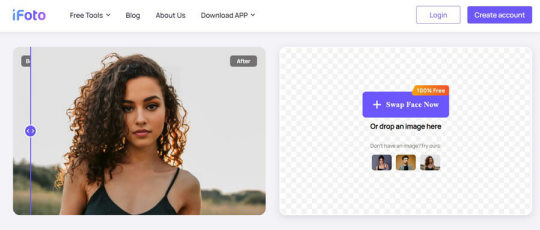
Step 2: Select the face to be swapped Once the image is loaded, you will get several options on iFoto. For instance, you can go to its sidebar and select any face to be swapped. Here, you can find model images of different genders, age, ethnicity, and so on. You can simply select any face from the extensive list.
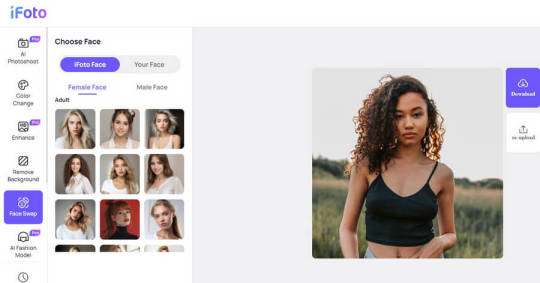
Alternatively, you can also upload an image of your choice on iFoto. Just click on the “Your Face” option from the sidebar and upload the image from which the face has to be cut-out. You can click on the add icon to browse and load the image of your choice.

Step 3: Swap faces and save the edited image Once both the images are uploaded, iFoto will process them, and will let you know once it is completed.
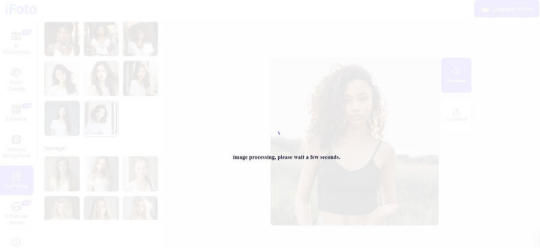
That’s it! You can now preview the results of the face swap and save the edited image by clicking on the “Download” icon adjacent to the image.
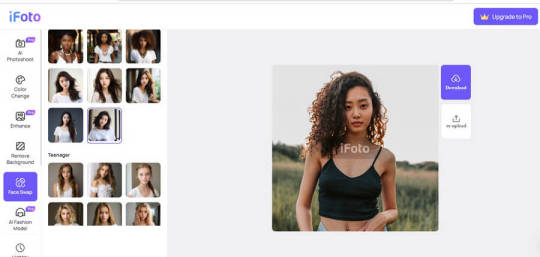
Conclusion
After following this guide, you can easily learn how to face swap in Photoshop. While the tool has been around for a while, it still takes a lot of time and effort to do face swap in Photoshop. That’s why you can consider a sophisticated AI-based tool like iFoto Face Swap that can instantly meet your requirements. The online tool is freely available and has a user-friendly interface, letting anyone (without even editing experience) swap faces in photos in seconds. Read the full article
0 notes
Text
AI in Education: Medium For Learning or Teacher’s Replacement

We stand on the brink of a revolution by Introducing “AI in Education”. The transformative potential of artificial intelligence is not just reshaping industries but is also redefining the way how we educate and learn. From healthcare to finance and from analytics to marketing, AI’s footprint is evident, but its most profound impact might very well be in the classrooms of tomorrow.
The world has witnessed rapid technological advancements in the field of AI in the past few years. Industries have evolved, businesses have transformed, and our daily lives have become intertwined with digital innovations. Among these, AI stands out as a beacon of change, indicating a new era of possibilities. And as it saturates every sector, education emerges as a prime candidate for AI’s transformative touch.
A future where every student gets a personalized learning experience, where educators are empowered with tools of unprecedented precision, and where the boundaries of traditional classrooms are expanded beyond physical walls.
This journey into the world of AI in education is not just about technology. It’s about harnessing its power to create more inclusive, engaging, and effective learning environments. It’s about understanding the vast potential and the challenges, ensuring that as we step into the future, we do so with vision, purpose, and a commitment to excellence.
The Multiple Benefits of AI in Education

The integration of “AI in Education” is not just a technological shift, it’s a revolutionary change that offers a wide range of benefits.
What are the advantages that AI brings to the educational table?
Personalized Learning: One of the most significant breakthroughs AI offers is the ability to tailor educational content to individual student needs. The one-size-fits-all approach days are gone. With AI-driven platforms, students can now receive customized lessons, ensuring that learning is aligned with their pace and style. This personal touch ensures that no student is left behind, and each one gets the optimal learning experience tailored just for them.
Efficiency and Automation: For educators, AI is nothing short of a boon. Routine administrative tasks, which once consumed a significant chunk of their time, can now be automated. From grading assignments to tracking student attendance and performance, AI streamlines these processes, allowing educators to focus on what they do best — teaching.
Enhanced Engagement: The digital-age student is tech-savvy and often seeks interactive and engaging learning experiences. AI offers gamification, virtual reality (VR), and immersive learning experiences. These tools not only make learning fun but also enhance retention and understanding, making education a truly interactive experience.
Support for Diverse Needs: Every student is unique, and so are their learning needs. AI recognizes this diversity and offers tools specifically designed for students with disabilities and different learning styles. Be it speech recognition tools for the differently-abled or adaptive learning platforms for those with learning challenges,
Data-Driven Insights: In the age of information, data is king. AI harnesses the power of data analytics to provide insights into student performance. Educators can now get real-time feedback, identify areas of improvement, and strategize teaching methods to ensure every student achieves their full potential.
The benefits of integrating AI into education are manifold. It’s not just about making processes efficient. It’s about redefining the learning experience, making it more personalized, inclusive, and impactful.
AI’s Role in Rural and Underserved Areas

AI in Education extends beyond the state-of-the-art classrooms in urban centres. Its true potential will shine when it’ll reach the corners of the world where traditional education systems have often stuttered.
How AI is making waves in rural and underserved areas.
Bridging the Educational Divide: For decades, rural areas have fought with challenges like limited resources, fewer qualified teachers, and outdated teaching methods.
AI will emerge as a source of hope in such scenarios. With AI-driven educational platforms, students in remote areas can access high-quality content, interactive lessons, and even virtual tutors. It’s not just about providing education, it’s about ensuring that the quality of education is on par with urban centres.
This democratization of learning is pivotal in levelling the playing field and ensuring that every student, irrespective of their geographical location, has a fair shot at a quality education.
Virtual Classrooms and Remote Learning Opportunities: The concept of a classroom is being redefined. No longer confined to four walls, AI-powered platforms are creating virtual classrooms where students from different parts of the world can come together to learn. These virtual spaces offer interactive lessons, real-time feedback, and even opportunities for collaborative projects. For students in rural areas, this means they can access courses that might not be available in their local schools.
The Teacher and AI: A Collaborative Approach
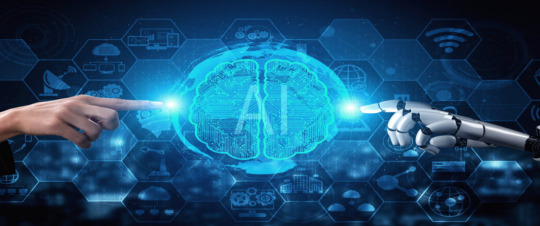
The Education industry often raises a fundamental question: Will AI replace teachers?
At the heart of every educational journey is the teacher, a guiding force whose impact goes beyond academics. AI, with all its advancements, cannot replicate the human touch, empathy, understanding, and mentorship that teachers provide.
Instead, AI serves as a powerful tool in the hands of educators. It amplifies their capabilities, provides them with resources, and ensures that they can cater to the diverse needs of their students more effectively. The essence of teaching remains human; AI merely provides the tools to make this process more efficient and impactful.
AI Enhances Teacher Capabilities and Reduces Burnout. It is a noble profession, but it’s also one that comes with its set of challenges. Administrative tasks, grading assignments, and managing large classrooms can lead to burnout. This is where AI steps in as a saviour. By automating routine tasks, AI allows teachers to focus on what truly matters which is interacting with students, providing mentorship, and crafting impactful lessons.
Likewise, with AI-driven insights, teachers can identify areas where students might be struggling and tailor their teaching methods accordingly. This not only enhances the quality of education but also ensures that teachers find their roles more fulfilling and less exhausting.
In the grand scheme of education, teachers remain the artists, crafting the future of their students with dedication and passion.
AI, in this scenario, is the brush, the tool that allows them to paint more vividly, ensuring that every student gets a masterpiece of education tailored just for them.
Ethical and Legal Implications of AI in Education

The integration of AI in Education is not without its challenges. As we use the infinite benefits, it’s crucial to address the ethical and legal implications that arise.
Data Privacy Concerns: With AI systems collecting vast amounts of data to provide personalized learning experiences, data privacy emerges as a paramount concern. Schools, institutions, and ed-tech companies must ensure that the data collected is stored securely, and any potential breaches could compromise the personal information of students. It’s not just about securing data; it’s about building trust. Parents, educators, and students need the assurance that their data is used solely for educational purposes and is protected from any misuse.
Unbiased Algorithms: AI systems are only as good as the data they’re trained on. If this data carries biases, AI algorithms can retain and even amplify these biases. In an educational context, this could lead to unfair assessments, misguided learning recommendations, or even discrimination. AI systems in education must be trained on diverse and representative datasets, ensuring that the outcomes are fair and unbiased.
Legal Considerations and the Role of Policy: As AI becomes more integrated into the education system, there’s a pressing need for clear legal frameworks. These frameworks should address issues like data ownership, accountability in case of AI errors, and the rights of students and educators.
Moreover, policies should be in place to guide the ethical use of AI, ensuring that its integration aligns with the core values of education.
Potential Drawbacks and Challenges of AI in Education

Alongside the numerous benefits, there are potential pitfalls and challenges that educators, policymakers, and stakeholders must address.
Dependence on Technology: As classrooms become more tech-centric, there’s a growing concern about over-reliance on technology. While AI-driven tools can enhance learning, they shouldn’t overshadow the fundamental human aspects of education. There’s a risk that students might become too dependent on AI for answers, potentially stifling critical thinking and problem-solving skills. It’s crucial to strike a balance, ensuring that technology complements, rather than replaces, traditional learning methods.
The Risk of Depersonalized Education: One of AI’s strengths is its ability to provide personalized learning experiences. However, if not implemented thoughtfully, there’s a risk of education becoming too mechanized and losing its personal touch. The human connection between teachers and students is irreplaceable and AI should aid this connection, not diminish it. While the lessons might be AI-driven, the human essence of mentorship, guidance, and support remains intact.
Infrastructure and Training Requirements:
Read the full article at: https://dsb.edu.in/ai-in-education-medium-for-learning-or-teachers-replacement/?utm_source=tumblr&utm_medium=tumblr&utm_campaign=tumblr+ai+in+education
#ai#india#fintech#jobs#blockchain#education#banking#chatgpt#gpt 4#google#students#learning#teaching#learn#higher education#educators
0 notes
Text
THE IMPACT ON OTHER ARTS AND WHAT WE CAN LEARN FROM IT
You may be aware of the ongoing strikes in Hollywood with protests against many decisions, including the use of A.I.
You've already seen it in action no doubt with the de-aging of actors on screen but the fear now is with a scan of your body and some dialogue, you can be represented on screen and paid only for the small contribution you made.
This leads to reduced wages and uncertainty to the future of not just actors but scriptwriters, directors and even musicians.
A.I is still in its infancy so there are errors, some more obvious than others to be found within their creations but who knows what progress will be made within the next 5, 10, 20 years.
We could be living in a World where everything creative could be made by machines and lack any human input other than a quick prompt and the real worry is, would anyone outwith the industries care?
We've seen the rise of piracy over the years when it comes to music and tv/movies. We're aware of the negative loss in earnings it can have on those involved but it's not stopped.
We may even see it rise again due to the number of different streaming services created nowadays and the cost of living having people weigh up what they can afford.
We see it with art as well, peoples work being used without credit and not receiving a penny of it as someone has posted it online as their own.
The other impact of social media is what could be considered the over saturation of art found online, it's great that there's a platform for so many artists but the attention span of our species is getting shorter and shorter and people can't be bothered scouring so many pages and images trying to find exactly what they're wanting.
So with A.I all that hassle is saved. Much like going to the shops or ordering online, it's so much more convenient to type what you're looking for and add it to the basket, even have it delivered rather than wander aimlessly in the aisles and cart your bags back home.
Despite the impact of piracy, movies are still breaking records and bands are selling out across the world, sometimes for ridiculous prices so there is still a large enough fan base out there to not be affected but what is it they're doing that separates them from the rest.
It could be down to popularity, through building up a fan base due to previous works or they could be just starting out and offer something different, something unique that brings a freshness to the market.
And that's where the art World fails. There are incredibly talented artists out there that won't be getting the recognition they deserve as they're lost within the sea of others online, mostly people regurgitating the same stuff they've found on Pinterest and were "inspired" by.
We are also told what is valuable and sought after by curators and galleries which heavily restricts success for artists but this is where we can learn from the likes of the bands Black Flag and Bob Vylan who produced their own music and done all their own advertising after labels refused to sign them.
The use of digital media as well means art can be created so easily by taking an image and adjusting some effects. I've done it myself, I started off in graphic design but grew bored of how easy and unimaginitive it can be, from minimalist logos and mostly Helvetica typefaces, to adding a grainy effect, there is not much creation from scratch, most of it is borrowing others work and and playing around with it, just like A.I.
But within all of that copying and pasting are some truly talented individuals who are creative and able to make something from scratch and they are the ones who will get the bigger jobs and more money and rightly so.
A.I is not a creator, it is a generator, it has no thoughts, no emotions, it is not an artist and much like movies and music, people will be able to tell the difference between authentic art and that which has been created by a soulless machine.
But to do that, we need to do something different from everyone else, we need to inspire and motivate ourselves and each other to do better, to be brave and not afraid to explore the unknown, the art world needs something new and when we find it, we need to embrace it, encourage it and promote it in hope it reaches a new audience of future artists to abandon the ease of digital assistance in placement of anything else.
0 notes
Text
Marketing for Dispensaries: AI and Digital Marketing
With the broad easing of laws and regulations, the cannabis industry is becoming an increasingly saturated–and rapidly growing–marketplace. What was once a niche consumer space operating in a legal gray area is now a full-on legitimate force in the market. As new dispensaries and cannabis shops seem to be popping up every day, you need to do whatever you can to stay ahead of the competition. In addition to providing a superior product and top-tier customer service, marketing for dispensaries is proving increasingly vital. While there remains valuable opportunity for traditional out-of-home advertising, such as print ads, billboards, and bus benches, the digital space is an area that should really merit your focus. Digital marketing is a rapidly evolving field, and artificial intelligence (AI) could potentially revolutionize the way in which businesses manage their online presence in the coming years. What is Artificial Intelligence? AI, which many think of in connection with science fiction movies, has really come into its own in recent years. Technically speaking, AI is a mode of computer science where machines are created with the purpose of performing tasks that typically require human intelligence. If you have been following the rise of AI, you may have heard of a few tools that have popped to write text and produce images. While still in a rudimentary state in many respects, AI is quickly advancing, and by using the right data, it can potentially automate areas of your business that could save you some serious money. How Can AI Impact Digital Marketing? How exactly AI will play a role in digital marketing remains to be seen, but those in the industry can see it playing out in a couple of ways. Customer service bots, in particular, could come to rely on AI. For your dispensary, being able to answer customers’ questions in this regard could produce real efficiency. Content creation, such as blog posts, YouTube videos, and social media posts could also be created via AI tools. As these aspects of digital marketing tend to be some of the most expensive, it would not be surprising to see businesses come to utilize AI in this way. The most immediate impact we may seem from AI, though, could be targeted ads. This is a digital marketing facet that requires a lot of data analysis, and AI could potentially streamline that process. Getting your business in front of relevant eyes is crucial in the digital arena, and any tool that could improve that strategy should be welcomed with open arms. Get the Best Marketing for Dispensaries – Work with Us! While AI may not have totally arrived yet, there are plenty of other ways to boost your digital presence in the cannabis marketing space. At Digital Mota, we work exclusively in this area, and we have a unique understanding of the industry. Whether you need SEO assistance, social media strategy, or web design, we can help. To learn more, contact us today to schedule your initial consultation with a digital marketing expert.
0 notes
Text
How to Dominate 2023 As a Creator
Every year, I make a series of stories on Instagram giving my thoughts on where I’m concentrating marketing efforts for the next year based on current trends and such. I don’t think I’m going to have time to really do that this year, or I might! Still, I wanted to put these in writing this year. Some things on my list end up being right calls, others not so much — but I pivot! As you should always be open to doing!
Last year a few of the things I talked about included the imminent near total crash of the NFT market and why I wasn’t jumping in, the accelerating heavy pivot to video on all platforms, and the continued trends of short-form video content exploding in popularity.
Those who follow me know I always preach three things when it comes to online content: make it good, make it consistently, and make it on your own platform.
Looking ahead to this year, I think that mantra is going to become very important, including the last one.
Overall Trend
The overall trend I’m seeing in 2023 is the quickly dawning mass realization that social media isn’t a viable place to build an audience on exclusively. Be it people burned by major platform changes, platforms collapsing, etc. — it seems that more and more people are realizing the importance of building your own platform with your own audience. This is the biggest trend I see catching on in 2023 and it is what everything else is filtered through.
Dichotomy of Video Content
Video content is quickly going in two different directions. On one hand, short-form content has finally completely exploded onto the marketplace. 10-30 second videos are major winners. On the other, longer-form videos are also proving quite successful. Videos at 6-20 minutes are dominant on YouTube and well watched. A successful content strategy in 2023 will rely on both ends for success which is exactly my plan.
Photography is Viable*
Still photography is going through a bit of a crisis right now in the sense that current trends are unfavorable for it on the most popular distribution platforms. Even more pressing is AI generated content is quickly beginning to come onto the scene which is going to impact photography in ways people are …probably… underestimating. Photography will always have a place in content and in the upcoming year I will be exploring more ways to make photography a storyteller vs. just something that is pretty.
Content Saturation and Fatigue is Increasing
People have seen incredible photos of Yosemite. They’ve experienced thrilling videos of a tornado nearby. They’ve seen timelapse segments of just about every possible thing. At this point, it is really hard to show visuals of something completely new that won’t elicit a “haven’t I seen this before?” feeling from huge sections of any generalized audience. What is going to become important to differentiate your product/brand in 2023 is learning how to incorporate YOU into your visuals and story. The most unique selling point anyone has is themselves, and that is going to become more and more important in the years to come. Its time to learn to be comfortable on camera if you haven’t already (I’m tripling down).
The Rise and Fall of Platforms
I think two major platforms are going to run into major headwinds this year. TikTok is about to run head first into a US government concerned about national security and Twitter is about to run head first into what happens when you are bankrupt. I actually think either TikTok getting banned in the U.S. or Twitter shrinking dramatically to the point it is unrecognizable will happen by year end. Any efforts I put here here will be spent putting into moving my audience to my owned platform.
Meta is Fine. Meta is Stable. Meta is Good.
There was a lot of breathless coverage of Facebook shrinking and losing money — the simple fact is Meta is making tons of profits on their social media wing and user numbers are going sideways to slightly up still. If they have to, they’ll cut some spending on VR to maintain profitability. I’m investing a slightly more into both Facebook and Insta this year as I think both are very stable platforms.
YouTube is the GOAT
There’s no better platform for creators. From the ability to connect with your audience to the best monetization policies of any creator-centric network, YouTube is by far and away the best option for creators. I ignored this platform for too long and I’m paying the price by playing catch up — but I’m investing a ton of time (AND money) into YouTube this year.
Owning Your .com and Audience
This is still the key to success. The Titan newsletter is quite large, and I’m super excited about the growth I’m seeing with it. Same with TornadoTitans.com. Regardless, I’m investing a lot more time and energy into these platforms this upcoming year, as I somewhat anticipate a bit of de-centralization of internet traffic in the coming year. It’s time you learn SEO.
Simplified Social Presence
I’m feeling it so I know others are too — we’re going to see many brands and creators scale back their ambitions a bit in 2023 to concentrate on fewer places they’re distributing content so they can increase the quality of community they are generating. It’s overwhelming right now otherwise! Currently, a lot of creators are distributing content in 4, 5, 6, or even more places. That’s unsustainable for individuals hoping to foster a real community, it definitely is for me. I’m bringing distribution channels down to 3 or so + my website.
#marketing#digital marketing#creator#creator entrepreneur#creator economy#social media#content marketing
5 notes
·
View notes